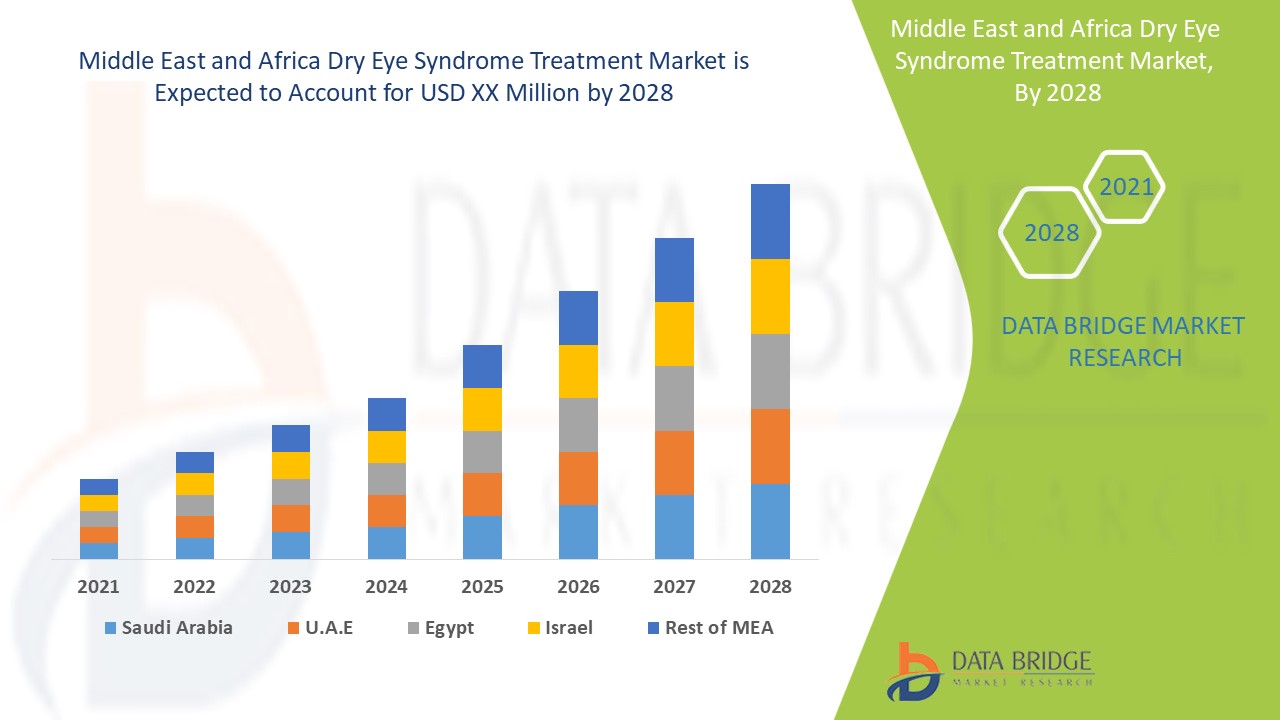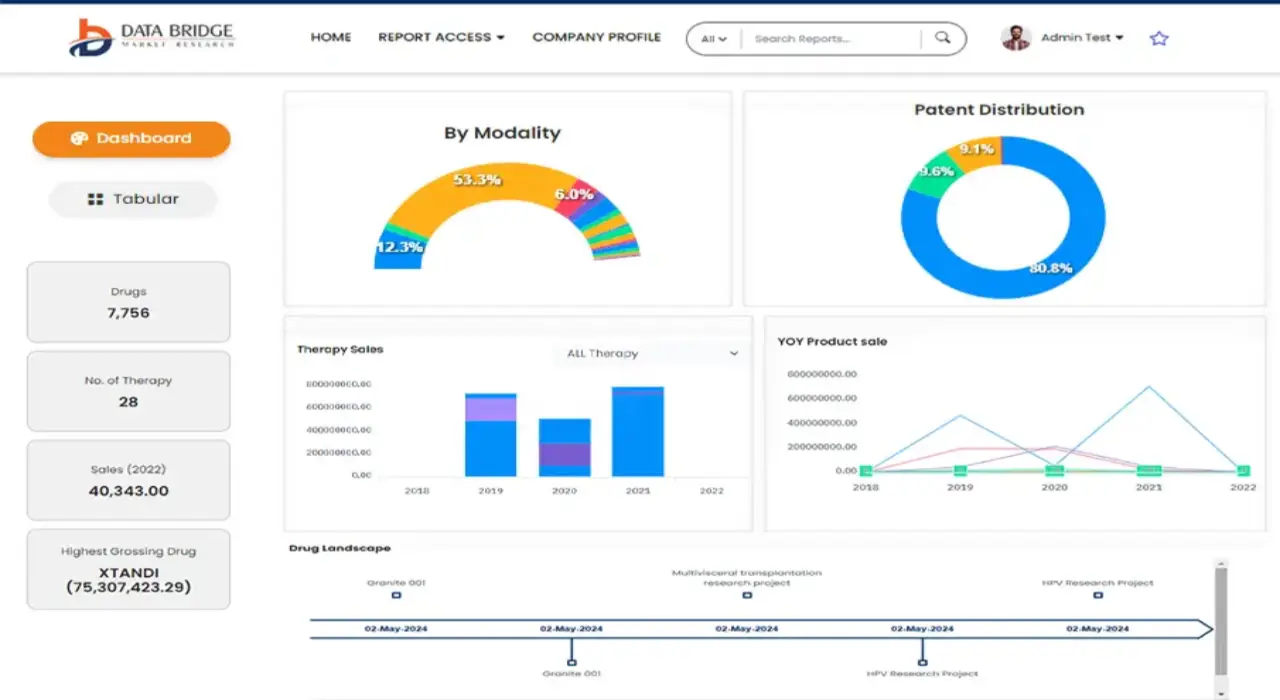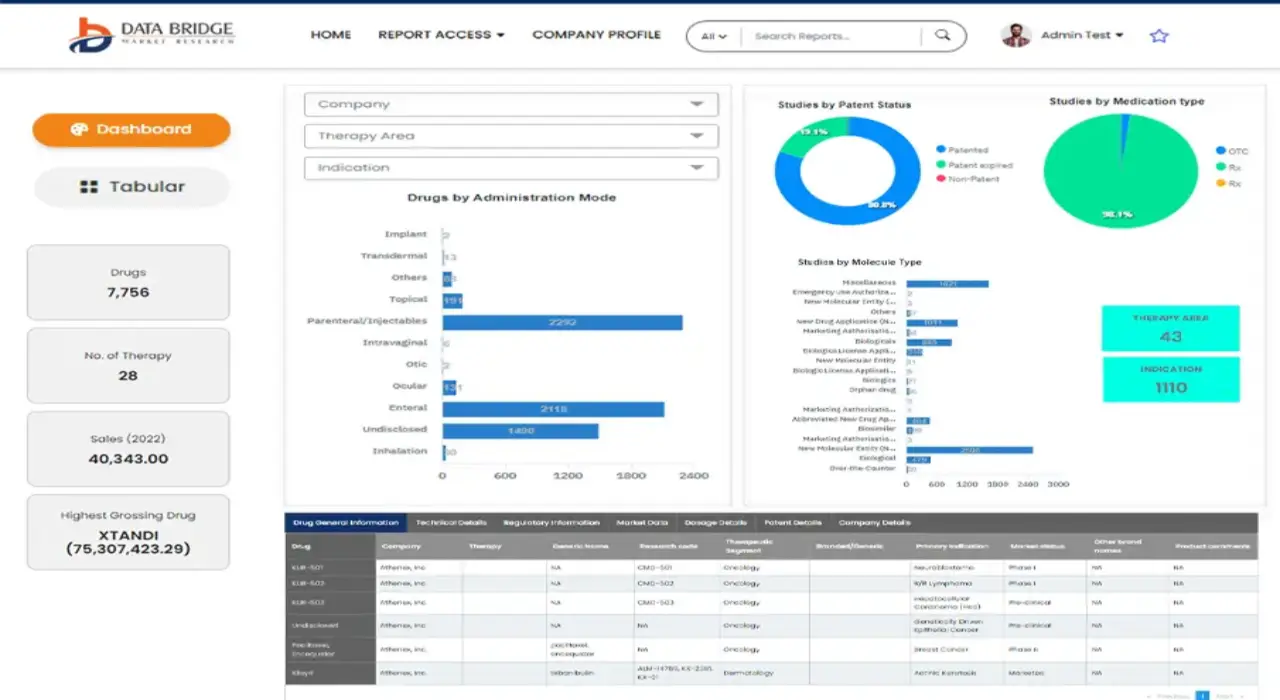Middle East and Africa Dry Eye Syndrome Treatment Market, By Type (Emulsions, Lubricant Eye Drops/Solutions, Eye Ointments, Autologous Serum Eye Drops, Nutrition Supplements and Others), Product (Cyclosporine, Corticosteroids, Lifitegrast, Ocular Lubricant, Punctual Plug and Others), Disease (Evaporative Dry Eye Syndrome and Aqueous Dry Eye Syndrome), Treatment (Lubricating Agents, Tear Stimulators, Artificial Tears, Anti-Inflammatory Drugs, Antibiotic Drugs and Others), End User (Home Healthcare, Hospitals, Clinics and Others), Distribution Channel (Retail Pharmacies, Hospital Pharmacies, Online Pharmacies and Others), Country (South Africa, Saudi Arabia, UAE, Egypt, Israel and Rest of Middle East and Africa) Industry Trends and Forecast to 2028.
 Market Analysis and Insights of Dry Eye Syndrome Treatment Market
Market Analysis and Insights of Dry Eye Syndrome Treatment Market
Data Bridge Market Research analyses that the dry eye syndrome treatment will exhibit a CAGR of around 8.00% for the forecast period of 2021-2028. Growing demand for targeted mode of therapies, surge in the research and development activities for the development of novel drugs and therapies, increasing prevalence of eye related disorders and increased expenditure for the development of healthcare infrastructure are the major factors attributable to the growth of dry eye syndrome treatment market.
From the name itself, it is clear that dry eye syndrome is a medical condition wherein there is lack of moisture and lubrication in, around and on the surface of the eye. Medically known as keratoconjunctivitis sicca (KCS), dry eye syndrome is a commonly occurring disease and its symptoms include aching and burning sensations, sore eyes, red eyes, fatigued eyes, itchy eyes, and photophobia, among others.
Ever-rising geriatric population base coupled with growing prevalence of deficiency of vitamin A is a major factor fostering the growth of the market. Rising expenditure on the development of healthcare infrastructure, growing demand for better treatment options, rising awareness among population in regards to the early diagnosis, growing contribution of non-governmental organizations towards the disease and upsurge in the diagnosis rate are other factors also fostering the growth of the market. Increasing personal disposable income is other indirect determinant that will create lucrative market growth opportunities.
However, unfavourable reimbursement scenario in the developing and under developed economies will pose a major challenge to the market growth. Also, high costs associated with research and development proficiencies will further derail the market growth rate. Lack of awareness in the underdeveloped and backward economies, high cost of specialty dry eye products and availability of alternative therapies will also hamper the market growth rate.
This dry eye syndrome treatment market report provides details of new recent developments, trade regulations, import export analysis, production analysis, value chain optimization, market share, impact of domestic and localised market players, analyses opportunities in terms of emerging revenue pockets, changes in market regulations, strategic market growth analysis, market size, category market growths, application niches and dominance, product approvals, product launches, geographic expansions, technological innovations in the market. To gain more info on dry eye syndrome treatment market contact Data Bridge Market Research for an Analyst Brief, our team will help you take an informed market decision to achieve market growth.
Dry Eye Syndrome Treatment Market Scope and Market Size
The dry eye syndrome treatment market is segmented on the basis of type, product, disease, treatment, end user and distribution channel. The growth amongst these segments will help you analyse meagre growth segments in the industries, and provide the users with valuable market overview and market insights to help them in making strategic decisions for identification of core market applications.
- Based on the type, the dry eye syndrome treatment market is segmented into emulsions, lubricant eye drops/solutions, eye ointments, autologous serum eye drops, nutrition supplements and others.
- On the basis of product, the dry eye syndrome treatment market is bifurcated into cyclosporine, corticosteroids, lifitegrast, ocular lubricant, punctual plug and others.
- On the basis of disease, the dry eye syndrome treatment market is segmented into evaporative dry eye syndrome and aqueous dry eye syndrome.
- On the basis of treatment, the dry eye syndrome treatment market is segmented into lubricating agents, tear stimulators, artificial tears, anti-inflammatory drugs, antibiotic drugs and others.
- On the basis of end user, the dry eye syndrome treatment market is segmented into home healthcare, hospitals, clinics and others.
- On the basis of distribution channel, the dry eye syndrome treatment market is segmented into retail pharmacies, hospital pharmacies, online pharmacies and others.
Dry Eye Syndrome Treatment Market Country Level Analysis
The dry eye syndrome treatment market is analysed and market size insights and trends are provided by country, type, product, disease, treatment, end user and distribution channel as referenced above.
The countries covered in the dry eye syndrome treatment market report are South Africa, Saudi Arabia, UAE, Egypt, Israel and Rest of Middle East and Africa.
Saudi Arabia in Middle East and Africa region dominates the dry eye syndrome treatment market owing to the earliest adoption of advanced healthcare technologies, growing prevalence of eye related disorders and significant increase in the geriatric population base.
The country section of the dry eye syndrome treatment market report also provides individual market impacting factors and changes in regulation in the market domestically that impacts the current and future trends of the market. Data points such as consumption volumes, production sites and volumes, import export analysis, price trend analysis, cost of raw materials, down-stream and upstream value chain analysis are some of the major pointers used to forecast the market scenario for individual countries. Also, presence and availability of global brands and their challenges faced due to large or scarce competition from local and domestic brands, impact of domestic tariffs and trade routes are considered while providing forecast analysis of the country data.
Patient Epidemiology Analysis
The dry eye syndrome treatment market also provides you with detailed market analysis for patient analysis, prognosis and cures. Prevalence, incidence, mortality, adherence rates are some of the data variables that are available in the report. Direct or indirect impact analysis of epidemiology to market growth are analysed to create a more robust and cohort multivariate statistical model for forecasting the market in the growth period.
Competitive Landscape and Dry Eye Syndrome Treatment Market Share Analysis
The dry eye syndrome treatment market competitive landscape provides details by competitor. Details included are company overview, company financials, revenue generated, market potential, investment in research and development, new market initiatives, global presence, production sites and facilities, production capacities, company strengths and weaknesses, product launch, product width and breadth, application dominance. The above data points provided are only related to the companies’ focus related to dry eye syndrome treatment market.
The major players covered in the dry eye syndrome treatment market report are Mitotech, SA, Hindawi Limited, Johnson & Johnson Private Limited , Sun Pharmaceutical Industries Ltd., Otsuka Holdings Co., Ltd., ALLERGAN, Novaliq GmbH, Santen Pharmaceutical Co., Ltd, Prestige Consumer Healthcare, Inc., Horus Pharma, Senju Pharmaceutical Co. Ltd., VISUfarma, Akorn Operating Company LLC, Bausch & Lomb Incorporated, Teva Pharmaceutical Industries Ltd., Alcon., Santen Pharmaceutical Co., Ltd., Novartis AG, Similasa, Scope Ophthalmics Ltd among other. DBMR analysts understand competitive strengths and provide competitive analysis for each competitor separately.
SKU-
Get online access to the report on the World's First Market Intelligence Cloud
- Interactive Data Analysis Dashboard
- Company Analysis Dashboard for high growth potential opportunities
- Research Analyst Access for customization & queries
- Competitor Analysis with Interactive dashboard
- Latest News, Updates & Trend analysis
- Harness the Power of Benchmark Analysis for Comprehensive Competitor Tracking
Research Methodology
Data collection and base year analysis are done using data collection modules with large sample sizes. The stage includes obtaining market information or related data through various sources and strategies. It includes examining and planning all the data acquired from the past in advance. It likewise envelops the examination of information inconsistencies seen across different information sources. The market data is analysed and estimated using market statistical and coherent models. Also, market share analysis and key trend analysis are the major success factors in the market report. To know more, please request an analyst call or drop down your inquiry.
The key research methodology used by DBMR research team is data triangulation which involves data mining, analysis of the impact of data variables on the market and primary (industry expert) validation. Data models include Vendor Positioning Grid, Market Time Line Analysis, Market Overview and Guide, Company Positioning Grid, Patent Analysis, Pricing Analysis, Company Market Share Analysis, Standards of Measurement, Global versus Regional and Vendor Share Analysis. To know more about the research methodology, drop in an inquiry to speak to our industry experts.
Customization Available
Data Bridge Market Research is a leader in advanced formative research. We take pride in servicing our existing and new customers with data and analysis that match and suits their goal. The report can be customized to include price trend analysis of target brands understanding the market for additional countries (ask for the list of countries), clinical trial results data, literature review, refurbished market and product base analysis. Market analysis of target competitors can be analyzed from technology-based analysis to market portfolio strategies. We can add as many competitors that you require data about in the format and data style you are looking for. Our team of analysts can also provide you data in crude raw excel files pivot tables (Fact book) or can assist you in creating presentations from the data sets available in the report.












